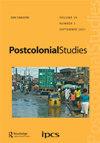Precarious duniyas in The Ministry of Utmost Happiness: life, death and repair in ‘ruin-worlds’
IF 1.8
3区 社会学
Q2 CULTURAL STUDIES
引用次数: 2
Abstract
ABSTRACT In The Posthuman (2013), Rosi Braidotti offers us a productive triangulation between the Anthropocene, the non-human, and the postcolonial. The post-human condition in the contemporary phase of late capitalism, Braidotti contends, seeks a relationality, a connection with geo/bio/techno environments, that can lead ultimately to an ethical relationship with radical Others. She thus provides a framework to examine precarity and the possible solidarities through which a new ‘post-human' subjectivity and politics may emerge. In this article, I examine Arundhati Roy's novel The Ministry of Utmost Happiness (2017), arguing that Roy's literary practices consummately carve a space for this post-human subject and its relational politics. The novel's structure, according to Roy, is meant to mirror that of a sprawling metropolis in the Global South, where planned spaces are constantly ambushed by encroachments by the ‘surplus and the unwanted’. The novel thus spatializes both precarity and the embryonic communities that emerge teetering on the porous borders between life and death, human and non-human, abandonment and community. I explore this spatialization through two sites that are central to The Ministry: the borderland of Kashmir and the urban crannies of Delhi - Old and New - where Roy locates affirmative alliances amid death and dereliction.极乐部的危房:“废墟世界”中的生、死与修复
在《后人类》(2013)一书中,罗西·布雷多蒂为我们提供了一种富有成效的三角关系,将人类世、非人类和后殖民时代联系在一起。Braidotti认为,在晚期资本主义的当代阶段,后人类状态寻求一种关系,一种与地理/生物/技术环境的联系,最终可以导致与激进的他者的伦理关系。因此,她提供了一个框架来审视不稳定性和可能的团结,通过这种团结,一种新的“后人类”主体性和政治可能会出现。在本文中,我研究了阿兰达蒂·罗伊(Arundhati Roy)的小说《极致幸福部》(2017),认为罗伊的文学实践完美地为这一后人类主题及其关系政治开辟了空间。根据罗伊的说法,小说的结构是为了反映全球南方一个不断扩张的大都市,在那里,规划好的空间经常被“过剩和不需要的”侵占。因此,小说空间化了不稳定性和萌芽社区,这些社区在生与死、人类与非人类、遗弃与社区之间的多孔边界上摇摇欲坠。我通过两个地点来探索这种空间化:克什米尔的边界和德里的城市裂缝——旧的和新的——罗伊在死亡和遗弃中找到了积极的联盟。
本文章由计算机程序翻译,如有差异,请以英文原文为准。
求助全文
约1分钟内获得全文
求助全文

 求助内容:
求助内容: 应助结果提醒方式:
应助结果提醒方式:


